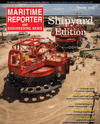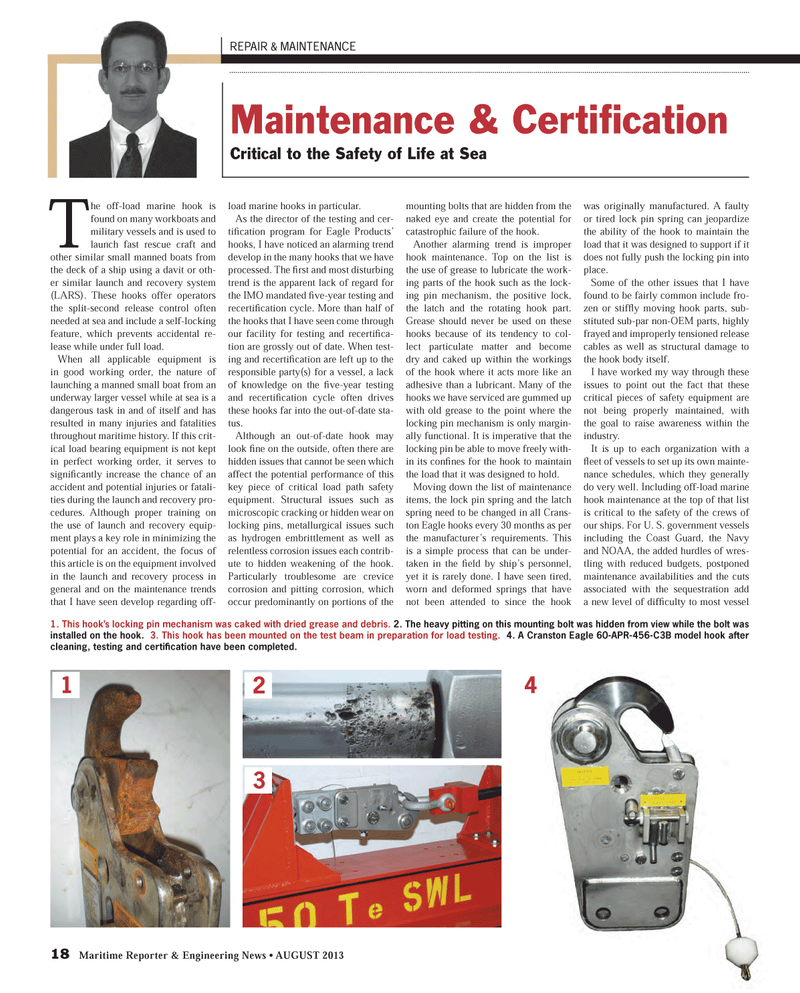
Page 18: of Maritime Reporter Magazine (August 2013)
Shipyard Edition
Read this page in Pdf, Flash or Html5 edition of August 2013 Maritime Reporter Magazine
18 Maritime Reporter & Engineering News ? AUGUST 2013 REPAIR & MAINTENANCE Maintenance & CertiÞ cationCritical to the Safety of Life at SeaThe off-load marine hook is found on many workboats and military vessels and is used to launch fast rescue craft and other similar small manned boats from the deck of a ship using a davit or oth-er similar launch and recovery system (LARS). These hooks offer operators the split-second release control often needed at sea and include a self-locking feature, which prevents accidental re-lease while under full load. When all applicable equipment is in good working order, the nature of launching a manned small boat from an underway larger vessel while at sea is a dangerous task in and of itself and has resulted in many injuries and fatalities throughout maritime history. If this crit- ical load bearing equipment is not kept in perfect working order, it serves to signiÞ cantly increase the chance of an accident and potential injuries or fatali-ties during the launch and recovery pro-cedures. Although proper training on the use of launch and recovery equip-ment plays a key role in minimizing the potential for an accident, the focus of this article is on the equipment involved in the launch and recovery process in general and on the maintenance trends that I have seen develop regarding off- load marine hooks in particular. As the director of the testing and cer- tiÞ cation program for Eagle Products? hooks, I have noticed an alarming trend develop in the many hooks that we have processed. The Þ rst and most disturbing trend is the apparent lack of regard for the IMO mandated Þ ve-year testing and recertiÞ cation cycle. More than half of the hooks that I have seen come through our facility for testing and recertiÞ ca-tion are grossly out of date. When test- ing and recertiÞ cation are left up to the responsible party(s) for a vessel, a lack of knowledge on the Þ ve-year testing and recertiÞ cation cycle often drives these hooks far into the out-of-date sta-tus.Although an out-of-date hook may look Þ ne on the outside, often there are hidden issues that cannot be seen which affect the potential performance of this key piece of critical load path safety equipment. Structural issues such as microscopic cracking or hidden wear on locking pins, metallurgical issues such as hydrogen embrittlement as well as relentless corrosion issues each contrib-ute to hidden weakening of the hook. Particularly troublesome are crevice corrosion and pitting corrosion, which occur predominantly on portions of the mounting bolts that are hidden from the naked eye and create the potential for catastrophic failure of the hook.Another alarming trend is improper hook maintenance. Top on the list is the use of grease to lubricate the work-ing parts of the hook such as the lock-ing pin mechanism, the positive lock, the latch and the rotating hook part. Grease should never be used on these hooks because of its tendency to col-lect particulate matter and become dry and caked up within the workings of the hook where it acts more like an adhesive than a lubricant. Many of the hooks we have serviced are gummed up with old grease to the point where the locking pin mechanism is only margin- ally functional. It is imperative that the locking pin be able to move freely with-in its conÞ nes for the hook to maintain the load that it was designed to hold. Moving down the list of maintenance items, the lock pin spring and the latch spring need to be changed in all Crans-ton Eagle hooks every 30 months as per the manufacturer?s requirements. This is a simple process that can be under- taken in the Þ eld by ship?s personnel, yet it is rarely done. I have seen tired, worn and deformed springs that have not been attended to since the hook was originally manufactured. A faulty or tired lock pin spring can jeopardize the ability of the hook to maintain the load that it was designed to support if it does not fully push the locking pin into place.Some of the other issues that I have found to be fairly common include fro-zen or stifß y moving hook parts, sub- stituted sub-par non-OEM parts, highly frayed and improperly tensioned release cables as well as structural damage to the hook body itself. I have worked my way through these issues to point out the fact that these critical pieces of safety equipment are not being properly maintained, with the goal to raise awareness within the industry. It is up to each organization with a ß eet of vessels to set up its own mainte- nance schedules, which they generally do very well. Including off-load marine hook maintenance at the top of that list is critical to the safety of the crews of our ships. For U. S. government vessels including the Coast Guard, the Navy and NOAA, the added hurdles of wres-tling with reduced budgets, postponed maintenance availabilities and the cuts associated with the sequestration add a new level of difÞ culty to most vessel 1. This hook?s locking pin mechanism was caked with dried grease and debris. 2. The heavy pitting on this mounting bolt was hidden from view while the bolt was installed on the hook. 3. This hook has been mounted on the test beam in preparation for load testing. 4. A Cranston Eagle 60-APR-456-C3B model hook after cleaning, testing and certi cation have been completed. 1243MR #8 (18-25).indd 18MR #8 (18-25).indd 188/1/2013 9:13:53 AM8/1/2013 9:13:53 AM

 17
17

 19
19
